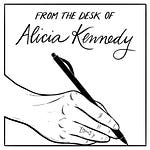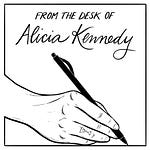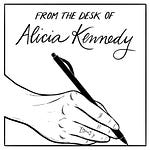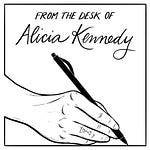Before the world disappeared from under our feet, I had the pleasure of meeting Carla Martin while she was doing field research into cacao in Puerto Rico. Her work as founder and executive director of the Fine Cacao and Chocolate Institute brought her to cacao farms around the world, and this complements her role as a social anthropologist and lecturer in the African and African American Studies department at Harvard University. I asked her about food media’s role in food studies, how to tell a good chocolate bar from one that’s not, and more.
Alicia: Hi, Carla. Thanks so much for coming on to chat with me.
Carla: Thank you for having me, Alicia. I really enjoy your newsletter and these weekly recordings, and I'm honored to be here.
Alicia: Can you tell me about where you grew up and what you ate?
Carla: Absolutely.
I grew up in Weymouth, Massachusetts, which is a town, a suburban town on the coast of Massachusetts, about 20 miles south of Boston. It is sort of tongue in cheek referred to as the Irish Riviera.
And the people that I grew up with, were primarily of Irish and Italian descent, working class, with parents who were members of local unions, etc. And as I grew, it also became a much more diverse town and absorbed many of the other immigrant communities that are in Massachusetts today. These are communities of Cape Verdean descent, Southeast Asian, Cambodian, Thai, Vietnamese, Haitian, Brazilian, and more. And so I grew up exposed to all of these different kinds of foods.
But I also had the really unique experience of generational food knowledge that was passed down. Both of my sets of grandparents were people who grew up during the Depression. And I grew up hearing stories about my grandfather being unable to stomach turnips any longer, after needing to eat almost exclusively turnips for years during the Depression.
I also grew up with a grandmother who, as soon as she was legally allowed to work, became a baker in her small town in Vermont, and learned to really deeply appreciate the local foods of Vermont, which in many ways is a place that championed local foods before local foods became like a buzzword of the moment.
And she then went on after marrying and having children to being the lunch — the exclusive provider of lunch to a New Hampshire elementary school, where she needed to cook from scratch over 200 meals every day.
And so, through her, through my other grandparents, I learned a lot about what local food meant in New England, what class or food scarcity had as an impact on food.
And then my own parents are big hippies. And so I grew up always with this kind of this thoughtfulness that they put around everything. They were always reading about something, trying to expose us to different things in our lives, trying to get us to think about what was — what were the stories behind what we might be consuming. Trying to get us to think ethically as moral actors in the world.
And so, most of my diet as a kid was, I would say, relatively vegetarian. I've gone on to become mostly vegetarian, vegan in my adulthood. And, there was all of that.
All of this was also colored at the same time by what we had access to on the South Shore. So, a lot of the food that I ate was from Shaw's Supermarkets, like it's what was there. And I can remember Shaw's Cakes as even still are nostalgically some of my favorite cakes to enjoy. They come with a 80 percent shortening frosting.
Once I was kind of old enough to operate in the kitchen safely, I would make mac and cheese and broccoli on the side for me and my brother. Stuff like that.
So, there's a long, I think, complex food history that I was lucky to be introduced to by people who were really thoughtful about it.
Once I became a bit older, and spent more time with friends, I also, through them, got introduced to the foods of these many different immigrant groups in New England. Things like linguica, sweet Portuguese bread, pão de queijo from Brazil, all kinds of different Cape Verdean or Haitian dishes, and really got to have adventures through food.
So for someone who spent well into her twenties, all of my life within about a 20-mile radius, food was in, a lot of ways, how I would explore and get to know other people.
Alicia: And how did your interest in chocolate come about? And how did that lead to your founding of the Fine Cacao and Chocolate Institute?
Carla: It actually came out of my interest in food to begin with.
When I graduated from college, I had the unique opportunity to travel to Cabo Verde, which is a small archipelago off the west coast of Africa. If you can kind of locate Senegal on the map, just look to the west of that. And that's where you'll find, with many Cape Verdean peers.
And what I was doing in Cabo Verde was teaching English. I was also, for a time, working with the singer Cesária Évora, who is one of the biggest kind of cultural exports of Cabo Verde. And as I came to learn more and more about the place, I also came to know a number of people who had spent time as conscripted laborers.
Basically, under Portuguese rule — Cape Verde’s a former Portuguese colony in Africa — people had been found to be indigent or delinquent under Portuguese law if they were unemployed. And they could be more or less forcefully sent to go and work in commodity production and other Portuguese colonies. One of the primarily — primary places that people were sent was to São Tomé and Príncipe, two small islands, also off the coast of West Africa, closer to Angola. So further south, than Cape Verde.
And what people were put to work doing was growing sugar, or growing cocoa. And I became really entranced by the story. It was the kind of thing that shocked me. I hadn't been aware that things like this happened a lot in these contexts.
And I also became really confused about how it was that people were making their way back and forth between Cape Verde and São Tomé to me, and even realized that many of the people coming back from São Tomé were disabled by the work that they had done, were left impoverished, existed in a type of indentured servitude, or a debt slavery in São Tomé.
And many of them, of course, remained in São Tomé and began to receive pensions from the Cape Verdean government, which was something that really just blew my mind that one government would be sending pensions to its diaspora in another country to support
them.
And of course, I was thinking to myself all along, this was for sugar and for cocoa, these two things that we don't necessarily even need. How could it be that these things that I had always loved as luxuries or sweet things were underpinning, were held up by such problematic labor conditions?
I then returned to the United States and entered graduate school. And I was in a program for African and African American Studies, and was one day at a local Whole Foods in Cambridge, Massachusetts, I picked up a chocolate bar from Lake Champlain Chocolates that advertised itself as a São Tomé origin. And I had it, I liked it. And I thought, ‘Well, that's kind of interesting.’
I then went to Formaggio Kitchen, which is the place that — it's the kind of elite specialty grocer in the Cambridge area, and found another bar that was actually made in São Tomé by a chocolate maker known as Claudio Corallo.
And I just became fascinated by this idea that here were these products being advertised to American consumers, as — of São Tomé's cacao, as something that was supposed to be interesting and flavorful and fabulous. But there was nothing being said about that complex production that went on behind the cacao and the labor.
So, that really drove me to try to learn more, to better understand what was going on in the supply chain, and try to really dig into it. Fortunately, in African and African American Studies, this is a discipline that provides us with all of the tools that we need to really analyze something like this.
So, I began digging in, I was writing my dissertation about something else. But I started focusing more on cocoa and chocolate, exploring all of these things. And once I graduated, I had the opportunity in a postdoctoral position to create a class at Harvard called ‘Chocolate, Culture, and the Politics of Food,’ which turned out to be one of the university's most popular classes.
And it became clear to me that one of the ways that I as an educator might draw people in to look at things like the history of slavery, of colonization, of inequality in contemporary commodity production, might be to basically bait them with chocolate and then switch upon arrival to talking about these tougher issues.
As I did all of that, I also found that I was repeatedly being approached by people in the chocolate industry, who were saying, ‘We see that you're teaching about this. How can we learn about this?’ I was tweeting at the time I was blogging, I was putting out a lot of information about what I was learning. And industry members were saying, ‘How can we basically get on this learning train?’
And that's when I was inspired to start the Fine Cacao and Chocolate Institute. I was actually advised by my mentors at Harvard, if you want to do these things and make them more publicly accessible, one way you could do that is through starting a nonprofit organization.
And so that was in 2015. I founded FCCI as a 501(c)(3) nonprofit. And I knew from the very start that I didn't want to do this kind of public facing work as a lone ranger. I wanted to do it in community. And FCCI has become a way of basically building a team of like-minded academics and industry members who want to do education and research on the cacao and chocolate industries, and who want to communicate about them differently.
We do this work now in a variety of different ways. We do it through educational programming for professionals and for consumers. We do it through research, and we do it through a lot of community building and communications activities. Historically, this has been through in-person, lectures, classes, events, and more, publications. But of course, in this COVID-19 moment, we've also been able to really prioritize a lot of multimedia communication. And that's become a bigger focus over the past year.
Alicia: Right.
So, you founded this institute, kind of in the — I would — from my perspective, like the peak of the craft chocolate boom in the US. How has the chocolate industry changed, from your perspective, if it has at all, since you founded the Institute and now?
Carla: Yeah, it's — in some ways, it hasn't changed at all. In other ways, it has changed a lot.
If we look at the industry as a whole, in the past 10 to even 20 years, it has gone through a reckoning in being forced to really deal with some of its biggest challenges. It's been forced to address things like forced labor, or the worst forms of child labor, to address things like deforestation. The variety of different kinds of sustainability buzzwords that the industry is not really allowed to ignore in its work.
At the same time, exactly as you said, the craft chocolate movement has gone through a large expansion. When it really started in the 2000s, it was — a very, a handful of Lone Ranger-type chocolate operations. Since the 2010s, this number has grown exponentially. There are now more than — thousands of companies that fit within this kind of small-scale chocolate making category globally, and that are really pushing the envelope on what it looks like to source cacao, and also to produce chocolate in an artisan fashion.
That, I think, has shown that — more than just a kind of experiment, this is, in many ways, a viable option for business. There are increasing numbers of businesses that are growing and expanding. They're not growing at the same rate as, say, craft beer, or cheese, or other specialty categories, but they are growing. They are learning a lot about how to interrupt the status quo operation of the chocolate industry or venture.
Alicia: And the words that are used in chocolate, “fine,” “craft,” “specialty,” “artisan,” can be challenging for a lot of people to understand when they're trying to buy a bar of chocolate. How do you define those? And what do you look for in a chocolate label?
Carla: Totally.
Well, they always say when people are hiring somebody, an HR committee will only look at a resume for however many of seconds? And I feel like that's what getting a chocolate bar is for so many people, and that's also very justified. For very few people in this world can grocery shopping be a leisure activity or a hobby, or like for me, an academic practice. So, it's completely justified. The system is set up such that people find it difficult to understand these different categories. So for anyone who's confused, I just feel like it's important to say that you're justified in your confusion. That the system is designed this way.
And so often, what I find helpful to do is to think about two separate industries in our mind. So one is cocoa or cacao, we use these terms more or less interchangeably. The other is chocolate. There is one kind of supply chain or value chain that links these two different things. But the way that sourcing and production happens is really quite different between the raw material, cacao, and the finished product, chocolate.
So, let's just focus on chocolates, as consumers are often focused primarily on that. It's helpful then to think of two different categories of businesses. One is chocolate makers, or manufacturers. These are the people that take the raw material, cacao, and they do things to process it to turn it into chocolate. So, there's quite literally starting with a bean and taking it to a finished product.
Then there's another category of people called chocolatier. Chocolatiers take pre-existing chocolate, so somebody already took it from the bean to chocolate, and those chocolatiers turn it into other things, Bonbons, truffles, bark, etc.
They're sometimes derisively referred to as melters in the industry, if that helps people think about it. There's nothing actually wrong with working in this way. In fact, it's a very profitable and helpful business. It uses up lots of chocolate, which uses up lots of cacao. There are many bonuses to this.
Now, within that, there are different categories. So, 99% of the chocolate that is out there today, it's within what is loosely construed as sort of a chocolate broadly construed, industrial construed, etc. category.
And much of that chocolate would actually properly be referred to as candy. We're speaking now in October. We're coming up on Halloween. And 99.9% of the Halloween candy in the world is produced by three branded retail manufacturers. So, when we talk about candy, when we talk about industrial chocolate, this is an enormously concentrated value chain where power and wealth are captured by a very few.
There's also another category of chocolate that is premium chocolate, and premium chocolate gets called it because it gets a price premium. That price premium is really coming about based on a perceived value that's somehow different than chocolate candy.
But the way that I think of as helpful to understand this is premium chocolate is, in many cases, just candy wearing a fancy costume. It might be, for example, a Hershey's product that has royal purple and gold, and that goes on the shelves before the holidays. It might be Lindt chocolate bar, that also looks as though it's in a more expensive packaging. But it's still probably made in just the same way as most industrial chocolate is.
Then, within premium chocolate, there are categories known as craft chocolate. That's a category that's drawing its inspiration from craft beer and other artisanal foods. Fine chocolate, also a category that is focusing on artisanry and more. And then a much lesser used term, but probably the most academically accurate term, which is specialty chocolate.
Now, within all of this, we also then need to go back to that first category that we talked about, which is cacao, or cocoa. Within this, there are ideas about the quality of the raw materials beyond just the quality of the finished product. So, we also have categories like fine-flavor cacao, and specialty cacao.
Fine-flavor cacao is defined in many ways as sort of genetically superior to other types of cacao. Specialty cacao is defined as cacao that receives a price premium based on its perceived quality. And so, there are certain chocolate companies that are making chocolate with these so-called better primary raw materials. They're also trying to produce an artisanal finished product. And all of that is leading them to this idea of being fine craft, or specialty chocolate.
Now, I know that that's a huge mouthful, and far more than the average consumer should have to parse. It's a huge burden and it's unfair. The industry itself is still struggling to even agree on these definitions.
Just take for example, craft chocolate. Craft chocolate is a divisive term even today. It is primarily used in the Americas. There are many companies in Europe, these old-world, we could call chocolate companies, that are making products that look really similar to what these bean-to-bar small batch craft chocolate companies are doing, say here in the United States.
But these European companies are loath to be lumped in with craft chocolate. They see themselves as doing the Grand Cru vintage style wine version of chocolate. And they see craft chocolate companies in the United States as doing this kind of cowboy, bold, messy flavor operation.
So it's dicey, even within the industry. But, some of what you're hoping to better understand?
Alicia: Yeah, absolutely.
Yeah, it's just so interesting, because I do think that chocolate is an entry point for a lot of people to think about supply chain issues, trade issues, the role of slavery in the past and in the present in food production. And so, I think it's just so rich, I mean, obviously, you know this. [Laughter.]
So yeah, I always think it's a good entry point for people. It was certainly my entry point to trying to think about these issues. And so I'm always so curious about how it's evolving, because it is such an expansive and — just, the world of chocolate is so vast that it is often difficult to get a grasp on.
Of course, it's a thing that through your — the institute, it — that is a necessary, such a necessary thing to exist because of how confusing and this whole world is. And that people don't know what to look for, even if they want to make better choices. And what you're talking about in terms of confusion, and how the — basically, the entire food system is set up that way to confuse the consumer.
I talk about this all the time with people where it shouldn't be the responsibility of people going to the grocery store to really dig in on the labeling and figure out where their food is coming from. The food should just be well produced and there shouldn't be all these ethical landmines everywhere in the grocery store for people. I talked about this with people who study the cattle, cattle’s effect on soil, because that's, of course, a huge issue.
And yeah, it's just, it just shouldn't be the responsibility of the consumer. And it's just so hard
to talk about all these things.
Carla: Yeah.
So, what I often try to tell people is basically you’re set up to more or less fail. What would be the ideal is, and I'm so in agreement, Alicia, is that this — basically, if you go into a store and you buy food, you should be able to be assured, just in buying it, that it was somehow good for people, the environment, the economy, etc. That is not guaranteed in any way.
And so, for people who need just a basic guide, there's kind of two categories of where you can find chocolate. One is, I would say, grocery writ large. So, this is grocery stores. This is a pharmacy. This is the site of public transportation, like airports, train stations, etc. The vast majority of chocolate that you're going to find in those places falls into this kind of industrial chocolate, or even candy category.
And so the way that I approach those is I flip the package over, I look to see the ingredients. I often hope that the first ingredient might be cocoa, or chocolate liquid, or something like that. If it's sugar, that's ok. Just be aware that what you're then getting is sugar that is flavored, like maybe milk and chocolate, not necessarily a focus product. So, evaluate those ingredients and see if they fit with you.
And then, it is better, in my opinion, to have some kind of sustainability certification at this point in time then not to have one in that type of grocery chocolate. Customers need to be skeptical of these certifications. They don't, for example, solve all social problems that exist in value chains. But they do provide a greater degree of traceability or information about the conditions of the production of those raw materials than anything else.
Then the other area where people can go and find chocolate that's been really growing, and that I hope will grow even further in — basically, in people's understanding, is the specialty category. And that means at specialty markets, or even at individual retail outlets of these different chocolate makers or chocolatiers that are working in this space.
And that tends to attract the customer that is looking more for a flavor-centric product. So, that requires an interest in things like origin, like flavor, like the conditions of its production or the artisanry that went into its production. It's like buying wine at Trader Joe's versus buying at a fancy wine shop. It's different categories of what people are looking for, and what kind of information is necessary to explore those categories.
Alicia: Right, right, right.
For this conversation series, I guess I can call it, I've talked to a lot of people who work in independent food media, traditional food media, but not a lot of food studies people. And so I'm curious how food media is perceived by someone who's working in academia and critical food studies, like how — what is the role that food media plays for people doing this work?
Yeah, I was on an NYU food studies panel last week, and it was me and just food writers. It was funny to just be watched by people who are really digging in and studying food and we're — but we're the people who communicate about these things to the public. And we're maybe not necessarily as well versed. We're always looking for academics to talk to about issues.
And so, yeah, just how is food media perceived by — in your work? And how do you use food media?
Carla: Yeah, yeah.
Well, it's so interesting, because I see food media as part of the bigger microcosm of just media. And academia in its most kind of elite and insular gut uses a lot of media.
But I am much more kind of an applied, or public focused academic. And there are, is a large number of us. There's a new generation of the way that people think about this, that see media as essential.
At the same time, both academia and media have gone through the very heavy process of privatization, the casualization of labor, and more, that has profoundly impacted what people are able to do, what they're able to say, how they're able to make money and survive, while also trying to do the important work that they aspire to. And so I see that as a big interruption on both sides of this fence, if it is a fence.
So, for me, food media is a regular part of my reading, or listening, or viewing diet. It's essential for just picking up what people are thinking about. It's an essential way, also, if you hope to communicate some of the much more, I would say complex, lengthy, wordy, different types of work that's done in academia.
And so I would never, I guess, presume to say that I know the different challenges that people in food media are facing. That said, there are a number of things that I think would make academic’s lives easier, who study cacao, chocolate, if food media — people involved in food media were to keep them in mind.
For example, approaching the study of cacao and chocolate, or the writing about it, the making of multimedia materials about it with the same seriousness as one approaches anything else would be really helpful. Chocolate is this area where we — that the biggest kind of pop culture character that we have is Willy Wonka. It’s silly in our culture, it is seductive, everyone is — it happens to me all the time.
People really think, ‘It's great, it's an escape, etc.’ However, it is just as much a part of the real world as anything else. And so approaching chocolate, while also celebrating the things that we love about it, but approaching it with that kind of seriousness would be really helpful.
Beyond that, chocolate is this kind of, I would say, poster character, as you described earlier for understanding value chains, or getting one pub right about the ethics of value chains. But a lot of what is said today is still profoundly racist. It is still profoundly anti-African. It is still profoundly ignorant about the history of slavery, contemporary labor practices. It's also often couched in very — Western understandings.
So, a lot of what people say about chocolate comes out of what they understand about wine. But wine is often being grown by white people in white places. It's a very different kind of product than a supply chain or value chain like cacao or chocolate looks like. So, there are very different factors that play into that.
So, these are the kinds of things that going into a deeper understanding of these would make academic’s lives easier, because there's a lot of noise out there in the world, about, ‘Avoid chocolate from these places, or avoid — don't eat this chocolate. It's made with slavery.’ These very kind of profound generalizations that don't serve anyone.
And it's also often coupled with a problematic assumption, that if you can just find the right chocolate, you'll be — you'll meet your salvation. You'll have checked off your moral and ethical box, without recognizing the fact that this is a profoundly unequal value chain. It was designed to be this way. It continues to be this way in the present day. And there's nothing kind of exciting and glamorous and fabulous about that side of the story of chocolate, no matter how much we might enjoy the flavor.
I see too often. And I've seen critiques of this in your own writing that I so appreciate this idea that if something tastes good, we can therefore extrapolate from that to assume that is good for people for the environment, and more. When in fact, those two things don't necessarily overlap in any significant way.
We often ask at FCCI, ‘What is the flavor of good intentions?’ No matter what the intentions might be of consumers, of chocolate makers, etc, if the effect is not such that the lives of cacao farmers are somehow benefiting or improving, it doesn't actually meet a standard that I think is a valuable one to uphold.
Alicia: Absolutely.
And for you, is cooking a political act?
Carla: Yeah, for sure.
Yeah, but I mean, so I feel like for a lot of people, this is such a personal question. It is, but so is pretty much everything that I do, feels very political. It's a thing, especially at this particular moment in the world. Everything feels highly political.
But it's also because the way that we operate in the world is — I think, we have to do things in community. We have to do things in groups. Cooking, and food are things that require doing these things, as groups of people, and that is therefore profoundly political and influenced by policy and politics.
Alicia: Well, thank you so much for taking the time out.
Carla: Thank you. It's been an absolute pleasure.















Share this post